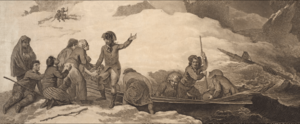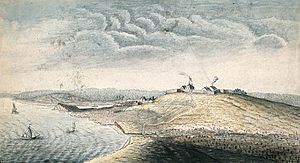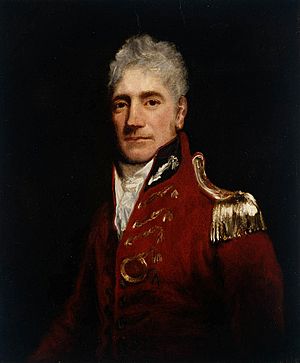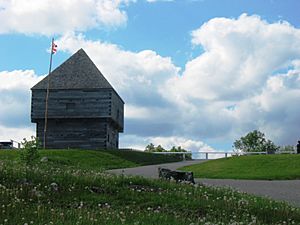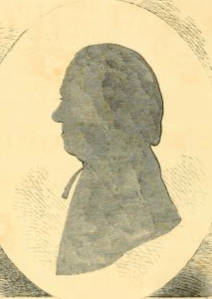84th Regiment of Foot (Royal Highland Emigrants) facts for kids
Quick facts for kids 84th Regiment of Foot (Royal Highland Emigrants) |
|
|---|---|

A British, Loyalist, soldier in The 84th Regiment of Foot (Royal Highland Emigrants) in traditional, kilted, uniform, drawn by a prisoner, in 1778, at Saratoga, Province of New York
|
|
| Active | 1775–1784 |
| Country | |
| Allegiance | |
| Branch | British provincial unit |
| Type | line infantry (auxiliary troops) |
| Role | infantry |
| Size | two battalions |
| Garrison/HQ | Fort Edward, Province of New York |
| Nickname(s) | Royal Highland Emigrants (1st Battalion), Young Highlanders (2nd Battalion) |
| Motto(s) | Quicquid aut facere aut pati (Whatever either is to be done or endured) |
| Colors | dark blue facings; the buttonhole lace was white, with red outer/blue middle/red inner worms; the colours were made up when the regiment was intended to be designated "77th Foot" and bore that number |
| Engagements | American Revolutionary War
First Battalion:
Second Battalion:
|
| Commanders | |
| First Colonel of the Regiment | Lieutenant General Sir Henry Clinton |
| Second (and final) Colonel of the Regiment | General Sir Guy Carleton |
| Notable commanders |
Allan Maclean (1st Battalion) John Small (2nd Battalion) |
The 84th Regiment of Foot (Royal Highland Emigrants) was a British army group during the American Revolutionary War. This group was formed to protect areas like present-day Ontario, Quebec, and Atlantic Canada from attacks by American Revolutionaries. The 84th Regiment also fought in the Thirteen Colonies, including places like North Carolina, South Carolina, Georgia, Virginia, and Maine. They also carried out raids on Lake Champlain and the Mohawk Valley.
This regiment had 2,000 soldiers divided into two main groups called battalions. Many of these soldiers were Scottish and had fought in the Seven Years' War. Because of this, the 84th Regiment had many experienced officers. These Scottish Highland regiments were very important to the British Army during the war. The 84th Regiment wore uniforms similar to the famous Black Watch regiment. Lieutenant Colonel Allan Maclean led the first battalion, and Major General John Small led the second. The two battalions usually fought in different places and rarely worked together.
-
Lt Colonel Allan Maclean, Commander, 1st Battalion
Contents
First Battalion
Protecting Quebec and Ontario
The British Province of Quebec was a large area that included parts of modern-day Quebec and Ontario. In 1775, American forces tried to invade this area.
Lieutenant Colonel Allan Maclean's Leadership
Lieutenant Colonel Allan Maclean of Torloisk was a brave war hero. He was given permission to create a new regiment from Scottish people living in Canada, New York, and the Carolinas. The 84th Highland Regiment was special because it was the first British regiment made up of American Loyalists. These soldiers had previously served Britain in the Seven Years' War.
It was risky to recruit soldiers in the Thirteen Colonies. Only two battalions were formed, even though five were planned. This was because it was so hard to find new recruits. When Maclean arrived in New York, he was told not to wear his uniform in public. He even dressed as a doctor when traveling alone to stay safe. The dangers of recruiting Loyalists became very clear after the Battle of Moore's Creek Bridge in North Carolina.
Battle of Moore's Creek Bridge
Members of the 84th Highland Regiment fought in the Battle of Moore's Creek Bridge in North Carolina in early 1776. On February 27, 1776, the regiment, with new recruits, was marching to Wilmington, North Carolina. They planned to meet other British forces there.
About 800 Loyalists faced 1,000 American Patriots. The Loyalists were blocked twice but managed to reach a bridge. Captain McLeod, a brave officer, was killed leading a charge. Half of the regiment was captured, and 30 were killed. Many officers and men became prisoners. Most of the new recruits from Carolina could not join the regiment after this battle.
Lt. Col. Donald MacDonald helped recruit in North Carolina and fought in this battle. Both MacLean and MacDonald were taken prisoner.
First Battalion Headquarters
In 1777, the First Battalion's main base moved from Quebec City to Sorel.
Fighting in Quebec
Under Maclean's command, the First Battalion mostly defended Quebec from American Patriot forces. They marched from Quebec to stop Brigadier General Richard Montgomery's invasion during the Siege of Fort St. Jean. The regiment tried twice to help the fort but had to return to Quebec. There, they helped keep the people's spirits up until General Carleton returned.
The regiment also fought in the Battle of Quebec. Montgomery and Benedict Arnold attacked Quebec City. During the battle, Captain McDougal led 120 soldiers from the 84th and 60 Royal Navy sailors. They defeated a group of New Hampshire troops, forcing them to surrender.
Fighting in the Thirteen Colonies
Later in the war, the First Battalion took part in raids. They raided Lake Champlain in 1778 and the Mohawk Valley in 1780, 1781, and 1782.
Second Battalion
Protecting Atlantic Canada
The 84th Regiment's Second Battalion was responsible for defending British areas in Atlantic Canada from American attacks. During the war, American privateers (ships allowed to attack enemy ships) caused a lot of damage. They raided many coastal towns, hurting the economy.
For example, Lunenburg, Nova Scotia was attacked in 1782. Liverpool, Nova Scotia was raided many times. Annapolis Royal, Nova Scotia was also attacked in 1781. There was even a sea battle with a French fleet near Sydney, Nova Scotia in 1781.
In 1775, General George Washington allowed some ship captains to become privateers. These ships, Hancock and Franklin, landed at Charlottetown, Prince Edward Island, in November 1775. They then raided Canso, Nova Scotia. In 1779, American privateers returned to Canso and destroyed the fishing industry there.
To protect against these attacks, the 84th Regiment was stationed at forts. One important fort was Fort Howe in Saint John, New Brunswick. This fort was burned by privateers in 1775. Saint John was raided three more times before the 84th rebuilt Fort Howe.
In Newfoundland, American privateers attacked ports like Chateau Bay and Twillingate. Off Newfoundland, the 84th Regiment helped a British merchant ship defeat an American privateer in the Battle of the Newcastle Jane in 1776. Major Small also had soldiers from the 84th at Fort Frederick in Placentia, Newfoundland.
The 84th Regiment also defended Nova Scotia. In 1775, they attacked an American privateer near Lunenburg, Nova Scotia. Captain John MacDonald led the 84th. They captured the privateer and sailed it to Halifax.
There were also land attacks on Nova Scotia, like the Battle of Fort Cumberland. People worried that American Patriots might attack Halifax by land. Because of this, Major John Small moved the 84th Regiment's headquarters from Halifax to Fort Edward (Nova Scotia) in Windsor in 1778.
Major General John Small's Role
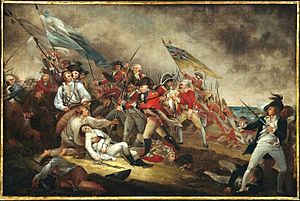
When Colonel Allan Maclean arrived in America, he found that Major General John Small was already forming a Highland Regiment. Small was recruiting Loyalists from the 13 Colonies and from Canada. He recruited soldiers who had fought in other Highland regiments, including the 42nd Regiment of Foot (Black Watch), where he had served. His new regiment was first called the "Young Royal Highlanders."
Small also recruited new immigrants arriving from Britain. For example, in 1775, a ship called the George arrived in New York with 172 Highlanders. Major Small went on board and convinced them to join the army. He promised their families would be cared for. The same thing happened with another ship, the Glasgow, carrying 255 Scottish immigrants.
Battle of Bunker Hill
Major John Small started forming the Royal Highland Emigrants on June 13, 1775. Just five days later, on June 17, Small and other officers from the 84th Regiment fought in the Battle of Bunker Hill. Small was a key figure in this battle. He led two regiments in attacking the hill.
Small was wounded in the arm by cannon fire. He later shared his experience with artist John Trumbull. Trumbull then painted his famous work, The Death of General Warren at the Battle of Bunker Hill, where Major Small is a central figure. The British won the battle, but it was very costly.
Fort Edward: Second Battalion Headquarters
Fort Edward (Nova Scotia) in Windsor became the main headquarters for the 84th Regiment in Atlantic Canada.
The 84th Regiment had soldiers stationed in many places. These included forts around Halifax, like Fort Needham and Fort Sackville. They were also at forts around the Bay of Fundy, such as Fort Anne and Fort Cumberland. Other locations included Cape Sable, Sydney Mines, and Fort Frederick in Newfoundland.
Because of the threat of land attacks on Halifax, Major Small moved the headquarters to Fort Edward in Windsor in 1778. The 84th Regiment worked on both land and sea. In June 1779, the 84th at Fort Edward captured twelve American privateers. These privateers had been stealing from ships and people in the Bay of Fundy.
Small put Captain Allan Macdonald in charge of Fort Edward for five years. Captain Macdonald was married to the famous Scottish heroine, Flora MacDonald.
Flora MacDonald's Story
Captain Allan Macdonald had fought in the Battle of Moore's Creek Bridge. He was captured and held prisoner for two years. After being released in 1777, he came to Fort Edward in Windsor, Nova Scotia. Major Small gave him command of the Second Battalion there. Two of his sons, Ranald and Charles, also served as young officers in the regiment.

Flora MacDonald married Captain Allan Macdonald in 1750. In 1773, they moved to North Carolina. Flora helped recruit men for the 84th Highland Regiment. She encouraged the 84th Regiment before they went to fight at the Battle of Moore's Creek Bridge.
After her husband was captured, Flora hid while American Patriots destroyed her home. When her husband was freed, she traveled with him to New York and then to Fort Edward in Nova Scotia in 1778. Flora only stayed at Fort Edward for one year. In 1779, she returned home to Scotland. Her husband followed her in 1784.
A plaque at Fort Edward honors Flora MacDonald. It quotes Samuel Johnson, saying her name will be remembered for her courage and loyalty.
Military Operations in Atlantic Canada
Battle of Newcastle Jane
On October 23, 1776, the 84th Regiment, led by Captain Murdock MacLaine, fought in the Battle of the Newcastle Jane. This was the first time a British merchant ship defeated an American privateer. The 84th Regiment was on the transport ship Newcastle Jane off Newfoundland. The ship carried money and uniforms for the regiment.
An American privateer attacked the Newcastle Jane. The American ship had more guns. After a 24-hour fight, the 84th Regiment outsmarted the Americans. The privateer was damaged, and many of its crew were wounded. The Newcastle Jane had almost no ammunition left.
Lachlan Macquarie's Start
A young recruit named Lachlan Macquarie was on the Newcastle Jane. He later became known as "the Father of Australia." Macquarie started his military career at age fourteen in 1776. After this battle, he joined the 84th Regiment. He served in Nova Scotia, New York, and Charleston.
Siege of Saint John (1777)
Machias, Maine was a base for American privateers attacking Nova Scotia. In 1776, privateers from Machias burned Fort Frederick at Saint John. In 1777, American forces briefly took control of Saint John. Major John Small personally led the 84th Regiment to drive them out.
When the 84th landed at Saint John on June 30, 1777, the Americans retreated. The 84th followed them into the woods and were ambushed. Weeks later, on July 13, American privateers attacked Saint John again but were pushed back. In August 1777, the Americans attacked successfully, stealing many goods. The 84th immediately started building Fort Howe, a stronger fort overlooking the settlement. Fort Howe helped stop privateer attacks and was a base for British operations.
Raid on Cape Sable Island
On September 4, 1778, the 84th Regiment, led by Ranald MacKinnon, raided Cape Sable Island. Privateers were threatening the island. The 84th surprised their ship at night and destroyed it. Brigadier General Eyre Massey praised MacKinnon for his brave actions. MacKinnon, however, was modest and said he was just doing his duty.
-
General Eyre Massey
Annapolis Royal Defense
On October 2, 1778, the 84th Regiment, led by Captain MacDonald, defeated an American privateer at Annapolis Royal, Nova Scotia. Captain MacDonald arrived by ship and found a large privateer raiding the port. He destroyed the privateer vessel. General Massey also praised his actions.
In December 1778, Captain Campbell of the 84th Regiment rescued an abandoned American privateer. He brought the ship safely back to Annapolis Royal. In 1780, Rev. Jacob Bailey became the Deputy Chaplain to the 84th Regiment. In 1781, another raid on Annapolis Royal led to prisoners being exchanged.
Military Operations in the Thirteen Colonies
Maine Operations
In November 1777, the 84th Regiment raided a fort at Castine, Maine. This port was used by privateers to attack Nova Scotia. Capturing it helped stop these attacks.
Southern Battles
The Second Battalion of the 84th Regiment fought in the Southern theatre of the American Revolutionary War. This was a major area of fighting in the second half of the war. Earlier, the 2/84th Regiment tried to capture Charleston, South Carolina, in the Battle of Sullivan's Island. On June 28, 1776, the 84th Regiment attacked Fort Sullivan. The British ships were heavily damaged, and the attack failed. Thirty-eight soldiers from the regiment died.
The 2/84th Regiment was also in a fight at Wiboo Swamp, South Carolina, in 1781. Three soldiers from the 84th and about 18 American Patriots were killed.
The 2/84th Regiment then helped protect the Loyalist stronghold of Augusta, Georgia. In April 1781, they fought at Wiggin's Hill, Georgia. The Patriots surprised the regiment but were pushed back twice. The 84th took prisoners, killed many, and burned their homes. Captain McKinnon tried to stop these harsh actions. The 84th also tried to protect Fort Motte in the Siege of Fort Motte, Georgia, in 1781. The 2/84th Regiment had to surrender on May 12 and were taken prisoner.
Siege of Ninety-Six
On June 18, 1781, the 2/84th Regiment helped American Loyalists who were surrounded by American Patriots in the Siege of Ninety-Six. The Loyalists were trapped in a fort. Lord Rawdon arrived with the 2/84th Regiment, and the Patriots retreated. The Loyalists in the fort were saved, but the British later left Ninety-Six.
John Bond's Journey
Captain John Bond was one of the Loyalists saved at Ninety-Six. He later moved from South Carolina to Rawdon Township in Nova Scotia. The town was named after Lord Rawdon, who had saved them.
Battle of Eutaw Springs
The American Patriots attacked Orangeburg, South Carolina, with 2,600 troops. The 2/84th Regiment was part of a British force that stopped them at the Battle of Eutaw Springs on September 8, 1781. In this battle, the 84th Regiment lost 6 killed, 22 wounded, and 2 missing.
Skirmish at Fair Lawn
In the last months of the war, the Second Battalion of the 84th Regiment was defending Charleston. They were involved in a fight at Fair Lawn. They were near a hospital with many wounded soldiers. They also guarded a bridge leading to Charleston. The captain had to choose between protecting the hospital or the bridge. He chose the bridge.
On November 17, 1781, American Patriots attacked the undefended hospital. They stole from it and then burned it down. Most of the wounded soldiers were dragged into the woods and swamps, where they died. After this, the 2/84th Regiment went to Georgia, Florida, and Jamaica.
Uniforms and Equipment
The 84th was unique because it was the only Highland regiment to keep its traditional Highland uniform throughout the war. This included plaids (a type of kilt) and swords. General Gage wanted them to look like the "Royal Highland Regiment."
The First Battalion first wore a green uniform with a long coat and a black hat. They used muskets from the Seven Years' War. Later, in 1777, they received kilts and wore them with their green coats. Eventually, these were replaced with red coats, like other regular British soldiers.
The Second Battalion had to get their own uniforms at first. Later, their uniform became standard: a short Highland-style red coat with dark blue parts and white turnbacks. They wore kilts of a specific pattern. Each soldier also received a bonnet, shirts, and a white wool waistcoat. In winter, they wore trousers and plaids together. Soldiers in Canada received extra warm clothing like blanket coats, overshoes, and snowshoes. Officers wore gold lace and buttons on their uniforms.
Disbanding and Settlement
After the American Revolution, many soldiers from the 2nd Battalion of the 84th Regiment became United Empire Loyalists. They moved to Nova Scotia. The 2/84th Regiment left North Carolina in April 1782 and arrived in Halifax on October 24, 1782. Major Small followed them.
Small also brought settlers that the 84th Regiment had saved during the Siege of Ninety-Six. These men founded Rawdon Township in Nova Scotia. After the 2nd Battalion was officially disbanded at Fort Edward (Nova Scotia) on October 10, 1783, many soldiers settled nearby in Douglas Township.
Major Small bought land in what is now Selma, Nova Scotia. He built a large house and named his estate "Selma." He hoped to create a special area there, but his wishes were not fully carried out.
The First Battalion mostly settled in Kingston, Ontario. Some returned to Britain. This original 84th Regiment was completely disbanded. It does not have any direct military descendants today. However, the Canadian Army sees the 84th as a historical link to the Stormont, Dundas and Glengarry Highlanders.
Images for kids
-
Lt Colonel Allan Maclean, Commander, 1st Battalion
-
Samuel Waller Prentice, 84th Regiment, shipwrecked off Cape Breton, Nova Scotia, in 1781.
-
Flora MacDonald by Allan Ramsay (artist)
-
General Eyre Massey
-
Major Small (center, standing) protecting Joseph Warren in a famous painting.
See also
- Military history of Nova Scotia
- King's Orange Rangers
- Nova Scotia in the American Revolution




